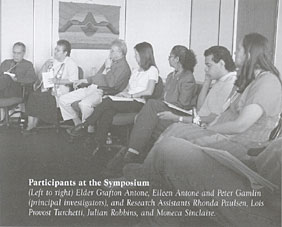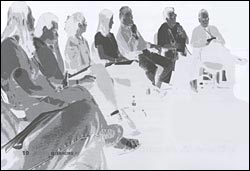Aboriginal Peoples: Literacy and Learningby Eileen M. Antone Introduction
Sekoli is a formal greeting in my language. Swa kwe kon includes everyone that is here. I am one of the Original People of North America also known to Aboriginal peoples as Turtle Island. I come from Onyota’a:ka, known as Oneida First Nation of the Thames, near London, Ontario. My name in the Longhouse is Tsyot sˆnit. Ka li wi suks is my research name. Ka li wi suks means “she who gathers information.” An elder who was a participant in my original thesis research gave this name to me. I am from the Turtle Clan. Eileen Antone is my English name. In working with Aboriginal literacy, it is important that I introduce myself in the Oneida language, as language is an integral part of the literacy of Aboriginal people. Identity is also an integral part of Aboriginal literacy, so it is important that I identify myself to you as a member of the Onyota’a:ka First Nation and a member of the Oneida Turtle clan. Historical Background
My original research was a sociological study of education for Aboriginal people in Canada. Through in-depth inquiry into the education of Aboriginal people in Canada, I found that the goal of the Euro- Canadian education system was to educate Aboriginal students to an individualistic worldview, based on the knowledge that came from Europe (Antone 1997). Education was a process of assimilation whereby Aboriginal People were to be absorbed into the Eurocentric society (Wilson 1986). The goal of the Euro-Canadian education system was to educate Aboriginal students to an individualistic worldview. The main strategy which the Government of Canada used to accomplish assimilation was the Residential School system, in continued existence from the late 1800s to the late 1900s in different parts of Canada. This system removed the children from their home communities and the influence of their parents and extended families (Knockwood 1992). The impact of these schools was that many Aboriginal people lacked the skills they needed for a high quality of life in either Aboriginal or European society (Barman 1986:112). Aboriginal practitioners began to explore and build connections between Aboriginal literacy, healing, community development and self-determination. Early literacy programs in Canada continued the aims of assimilation. They tried to teach learners to read and write in the English language so that they could find work in the dominant society (Barman 1986:112). These literacy programs did not seem to help, as Aboriginal people continued to have high unemployment rates (McCallum 1997). In 1987, Aboriginal people in Toronto began a literacy movement to improve the quality of education for their learners. Aboriginal practitioners began to explore and build connections between Aboriginal literacy, healing, community development and self-determination (Gaikezheyongai 2000). These visionaries saw another way, one not based on the constant negation of Aboriginal views and values (Battiste 1986). Their efforts to enhance literacy for Aboriginal people continue today. Literacy and Learning ProjectThe Literacy and Learning project collected data from Aboriginal communities in the province of Ontario between 2000 and 2002. The research team consisted of Dr. Peter Gamlin and myself as principal investigators, both from the Ontario Institute for Studies in Education at the University of Toronto (OISE/UT). We worked with five Aboriginal students: Moneca Sinclair, Ed.D. Candidate at OISE/UT; Lois Provost Turchetti, M.Ed. Candidate at OISE/UT; Julian Robbins, Ph.D. Candidate at Trent University; Rhonda L. Paulsen, Ph. D. Postgraduate student at OISE/UT; and Heather McRae, M.A. Candidate at OISE/UT. Heather joined us in the fall of 2002 to help bring this project to a close. The research was a collaborative work, in partnership with the National Literacy Secretariat, the Ontario Ministry of Training, Colleges and Universities and the Ontario Native Literacy Coalition (ONLC) and OISE/UT. The ONLC currently serves a membership of twenty-six Native literacy programs throughout Ontario. Our research data came from urban and rural Aboriginal communities affiliated with ONLC , as well as independent or stand-alone programs not connected to ONLC.
|
|
 The second phase of the research included
interviews and focus groups. The major objective
was to gather, document and understand the
experiences of program personnel and learners,
acknowledging Aboriginal wholistic
approaches to learning and “best
practices” in literacy training
programs. A second objective
was to identify the barriers and
supports experienced by
Aboriginal learners in literacy
training programs.
The second phase of the research included
interviews and focus groups. The major objective
was to gather, document and understand the
experiences of program personnel and learners,
acknowledging Aboriginal wholistic
approaches to learning and “best
practices” in literacy training
programs. A second objective
was to identify the barriers and
supports experienced by
Aboriginal learners in literacy
training programs.
The third phase of the research involved a two-day symposium. Nearly eighty practitioners came together for the Native Literacy and Learning–Aboriginal Perspectives Symposium held at OISE/UT on May 3 and 4, 2002. Elders Lillian McGregor and Grafton Antone provided opening and closing each day, respectively. Aboriginal literacy researchers Ningwakwe Priscilla George and Sally Gaikezheyongai gave keynote presentations. Lillian McGregor, Jacqui LaValley, Grafton Antone, Jan Longboat, and Joe Paquette provided a roundtable of Elders and teachers. Fourteen practitioners presented on a broad range of topics related to barriers and supports in literacy, ranging from “Healing the Spirit” to “Deaf Literacy”.
Culturally appropriate practice is flexible and effective because it reframes Aboriginal perspectives in a positive light.
The presenters, Elders and teachers who participated in the symposium were invited to a one-day follow-up workshop in mid-October 2002. Significantly, these gatherings created forums for Aboriginal literacy practitioners to come together and discuss issues that would enhance literacy for the learners in Aboriginal programs. These gatherings were also a way to encourage, enhance, recognize and validate practitioners’ accomplishments. Practitioners were able to develop teaching methods, practices and administrative processes and share their findings from the literacy teaching process.
Findings
Four clear and consistent findings came out of the interviews, symposium and follow-up meeting. First, there was complete agreement from practitioners that (a) Aboriginal literacy comprises a distinct, culturally-appropriate and wholistic perspective on literacy; and (b) a proactive response to this wholistic perspective needs to be taken.
Secondly, practitioners agreed that there is no single type of Aboriginal literacy program or “best practice”. Effective and successful programs and practices are those that learners perceive to be directly relevant to their own environments and cultural traditions. Consequently, effective and successful programs are those in which learners are motivated to participate.
Practitioners stated that culturally appropriate practice is flexible and effective because it reframes Aboriginal perspectives in a positive light. As long as funding arrangements are predicated on governmental criteria-based outcome objectives that do not take Aboriginal cultural perspectives into account, culturally appropriate practice cannot be recognized and achieved.
Practitioners also observed that there was very little understanding of, or funding support for, Aboriginal adult literacy programs that include intergene rational literacy participation and practices (Antone 2003).
Finally, practitioners described Aboriginal literacy as distinct from mainstream literacy in that it reflects Aboriginal worldviews in two particular ways. The first is the intergenerational or multigenerational expression of Aboriginal literacy which includes how literacy extends to all areas of life. The second is the particular learning process by which teachers become learners and learners become teachers. As Cajete (1994) describes it, this learning “unfolded through mutual, reciprocal relationships between one’s social group and the natural world... involved all dimensions of one’s being, while providing both personal development and technical skills through participation in community life.” Practitioners, learners and their families need this approach to achieve their place as respected and contributing members of both Aboriginal and Canadian society.
We must continue the work of our earlier visionaries by exploring and building connections between Aboriginal literacy, healing, community development and self-determination.
For more informationon the Symposium,
please see |
Eileen Antone is a member of the Oneida of the Thames First Nation. She is a faculty member in the department of Adult Education and Counselling Psychology at the Ontario Institute for Studies in Education, University of Toronto (OISE/UT). Dr. Antone also works with the university’s Transitional Year Program assisting Aboriginal students to achieve university studies.
| SOURCES: |
|---|
Antone, Eileen (1997). In Search of Voice: A Collaborative Investigation on Learning Experiences of all Onyota’a:ka. Toronto: Unpublished Thesis-University of Toronto. Antone, Eileen, Peter Gamlin and Lois Turchetti (2003). Literacy and Learning: Acknowledging Aboriginal Holistic Approaches to Learning in Relation to ‘Best Practices’ Literacy Training Programs Final Report. Toronto: Literacy and Learning. Barman, Jean (1986). “Separate and unequal: Indian and White girls at All Hallows School, 1884-1920”. In Indian Education in Canada Volume 1: The legacy. Eds. Jean Barman, Yvonne Hébert, and Don McGaskill. Vancouver: UBC Press. Battiste, Marie (1986). “Micmac Literacy and Cognitive Assimilation”. In Indian Education in Canada Volume 1: The legacy. Eds. Jean Barman, Yvonne Hébert, and Don McGaskill. Vancouver: UBC Press. Cajete, Greg (1994). Look to the Mountain, An ecology of Indigenous education. Durango, Colorado: Kivakí Press. Gaikezeheyongai, Sally (2000). Aboriginal-Enhanced Access to Native Learning. Toronto: Native Women’s Resource Centre. Knockwood, Isabelle (1992). Out of the Depths: The Experiences of Mi'kmaw Children at the Indian Residential School at Shubenacadie, Nova Scotia. Lockeport, Nova Scotia: Roseway Publishing. McCallum, John (1997). Aboriginal Economic Development. Royal Bank of Canada. http://www.royalbank.com/aboriginal/rr_economic.html#i Wilson, J. Donald (1986). “‘No blankets to be worn in school’: The education of Indians in nineteenth-century Ontario”. In Indian Education in Canada Volume 1: The legacy. Eds. Jean Barman, Yvonne Hébert, and Don McGaskill. Vancouver: UBC Press. |
View in PDF (303k) |

 Aboriginal education became the focus of my work
when I realized that, though I am an Aboriginal
person, I was unaware of my heritage and history. I
wanted to know why I did not have the traditional
knowledge that is the basis of Onyota’a:ka life.
Aboriginal education became the focus of my work
when I realized that, though I am an Aboriginal
person, I was unaware of my heritage and history. I
wanted to know why I did not have the traditional
knowledge that is the basis of Onyota’a:ka life. Methodology
Methodology
